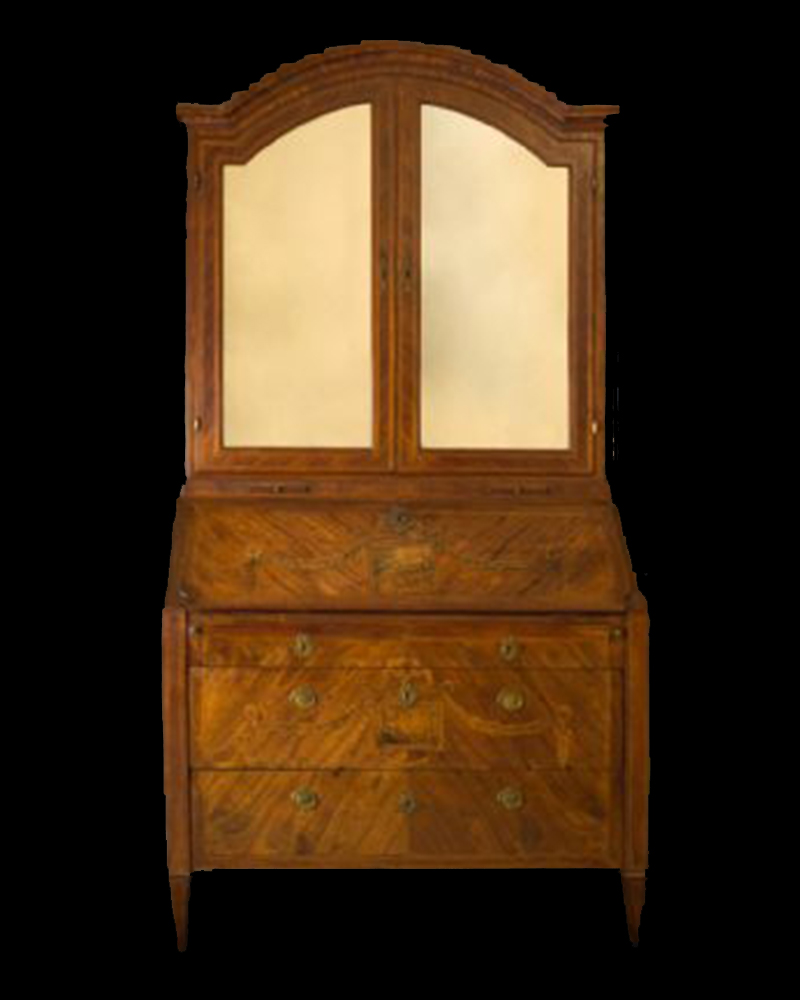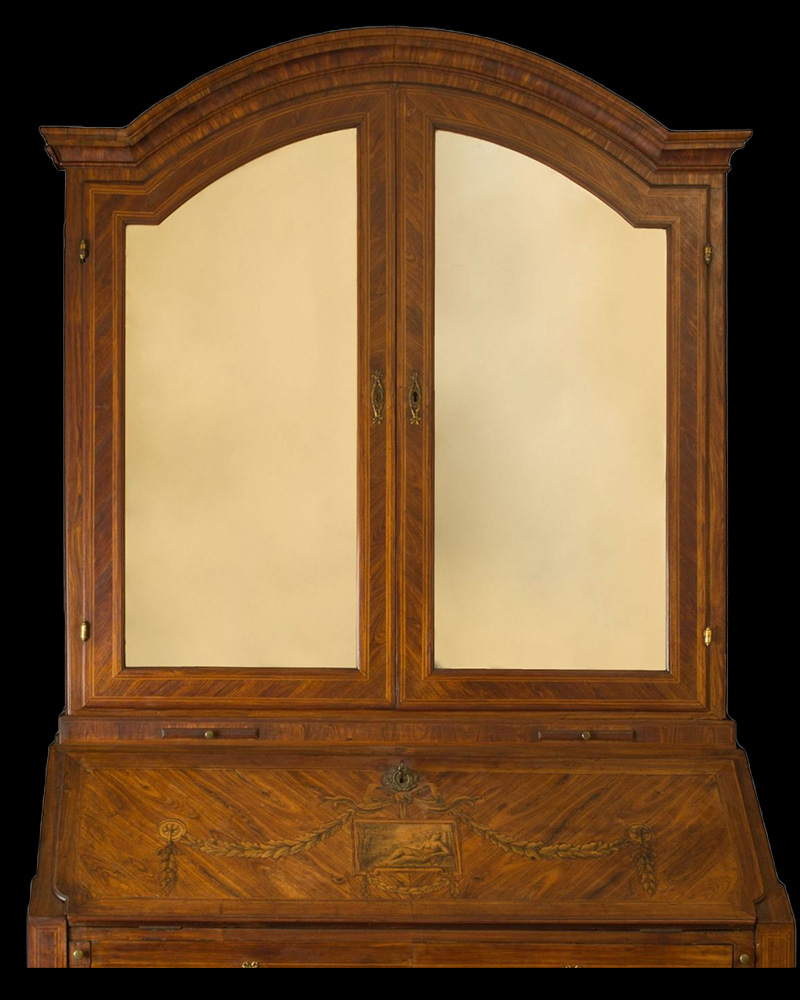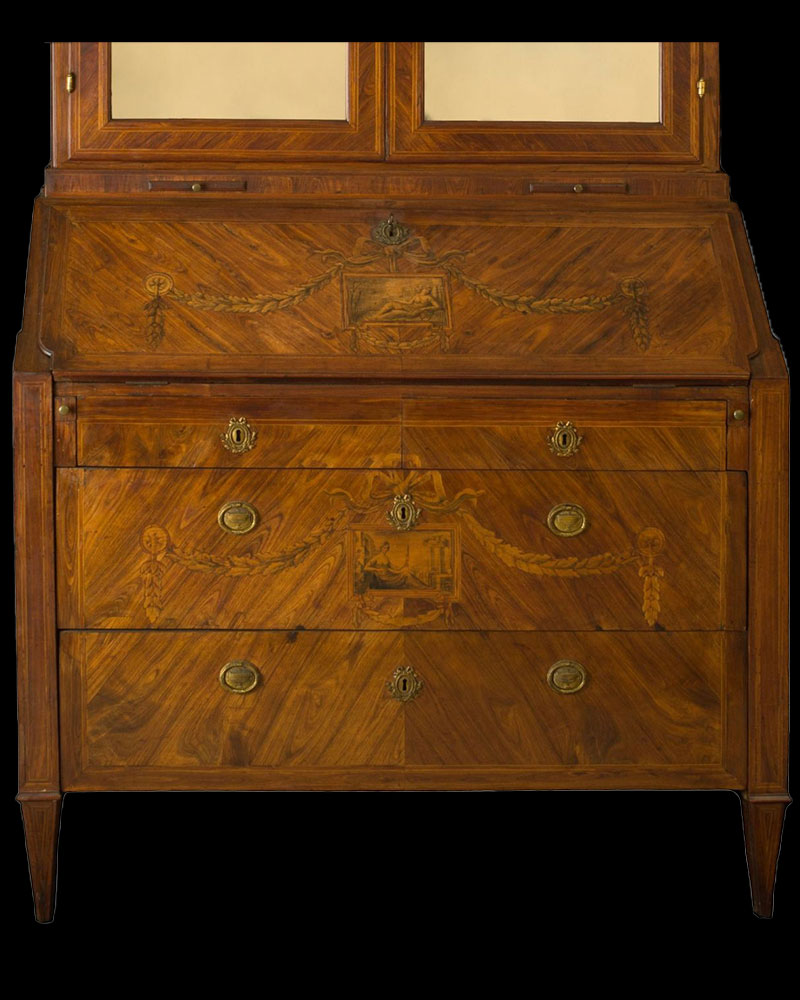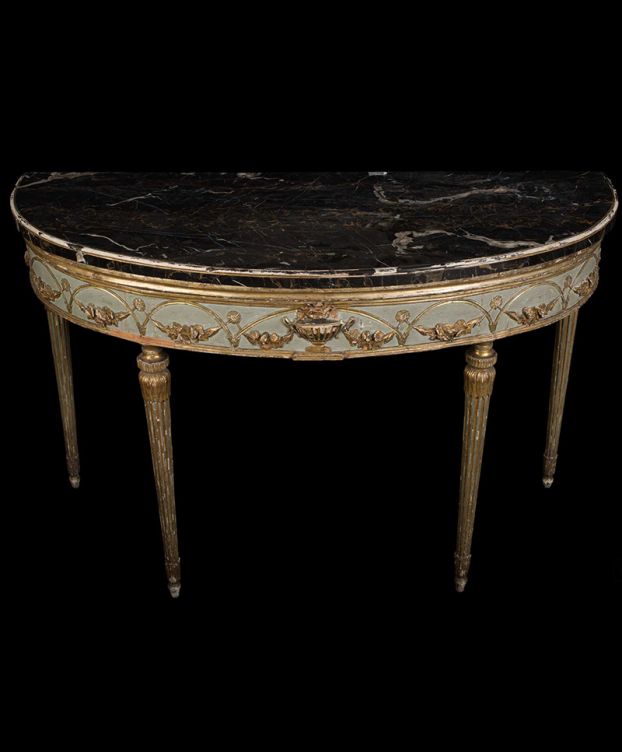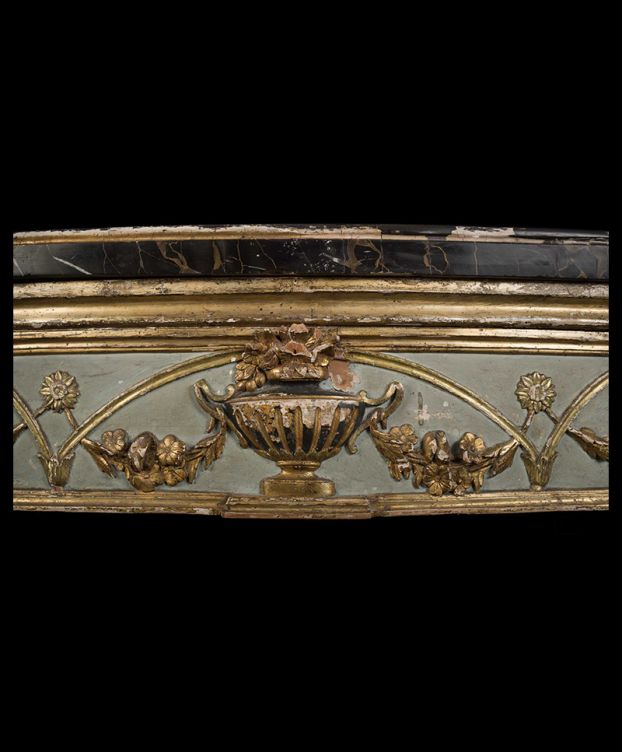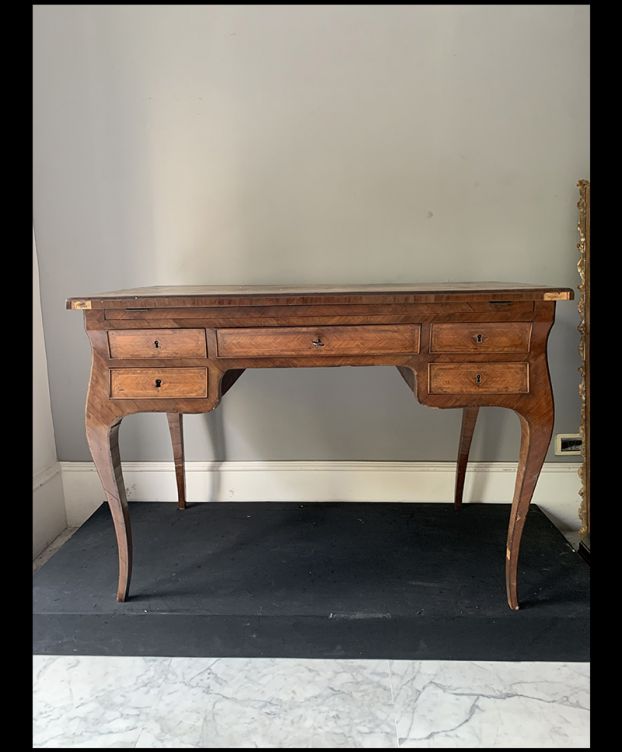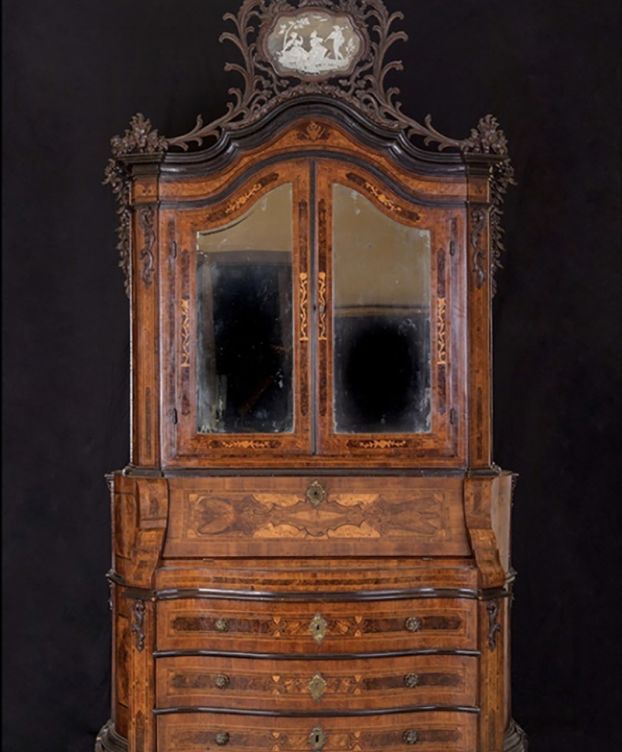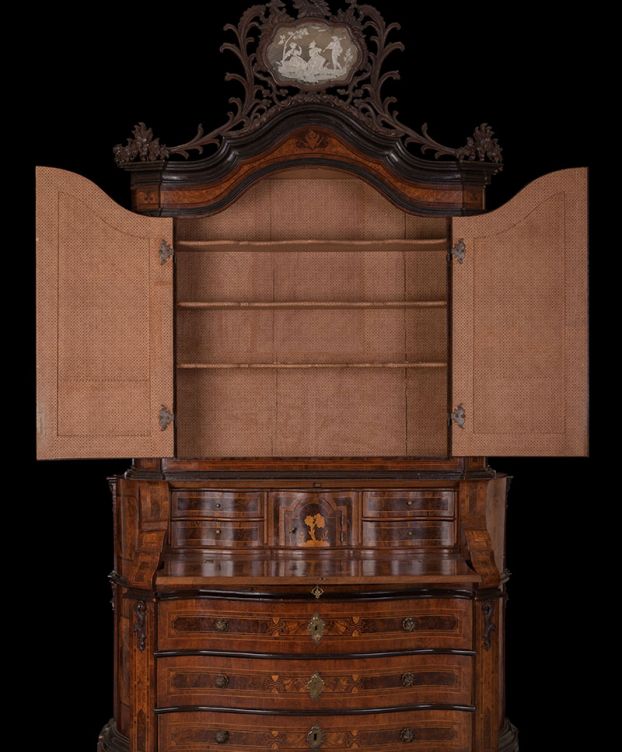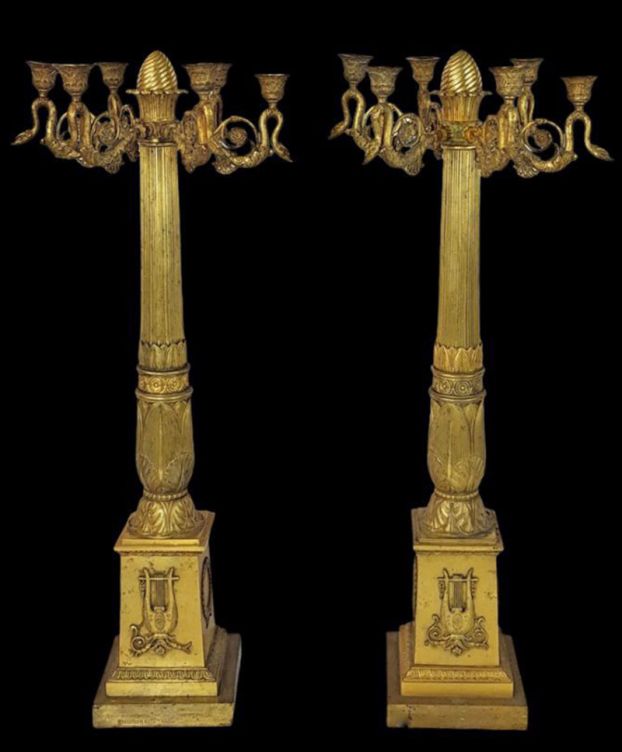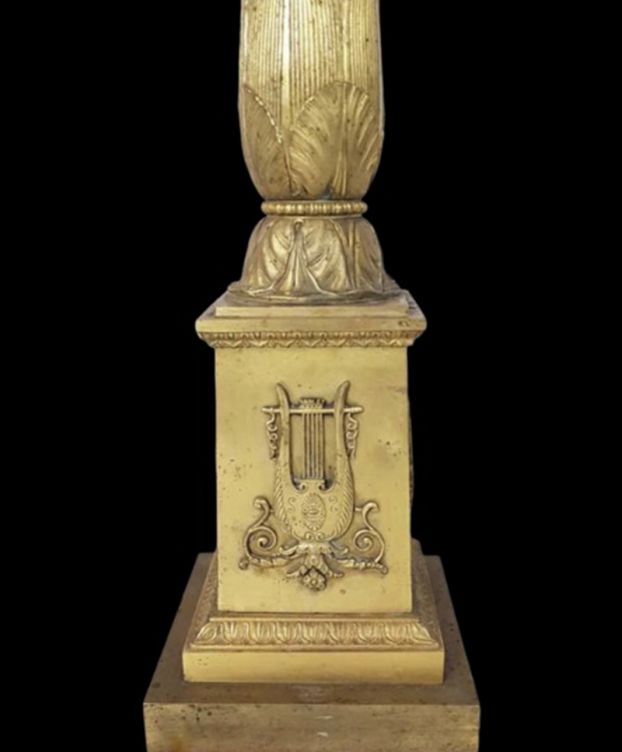Importante e raro trumeau genovese Luigi XVI in bois de voilette e bois de rose impreziosito da raffinati intarsi di gusto classicheggiante, vetri argentati originali, bocchette e maniglie in bronzo dorato. L'importanza del trumeau è sottolineata anche dalla sua pubblicazione nel volume "L'ebanisteria genovese del Settecento" di Lodovico Caumont Caimi.
Provenienza : Italia, Genova, maestranze genovesi
Epoca : Seconda metà del XVIII secolo Il trumeau è composto da un corpo basso strutturato intorno a tre cassetti e calatoia e da un corpo alto celato dalla presenze di due eleganti battenti vetrati culminante con una bella cimasa arcuata anche detta a "chapeau de gendarme". La raffinatezza di questo maestoso capolavoro di alta ebanisteria settecentesca genovese sembra concentrarsi tutta negli straordinari e certosini lavori d'intarsio e filettature che animano il fronte dei cassetti e della calatoia. Motivi di gusto classicheggianti come i festoni ed i nastrini incorniciano e dignitano i due riquadri centrali di sontuosa regalità, ben in linea con tutto il sobrio sviluppo dell'intero trumeau. Al centro dei citati riquadri fanno bella mostra di sè due donne distese, mirabile esempio di intarsio figurativo. Una delle due reca un bilancia in mano, chiara allusione alla giustizia.
Il resto del trumeau è scandito dalla lastronatura spesso disposta a spina di pesce e specchiata come sui cassetti e sul fronte della calatoia e segnata graficamente dalle deliziose ed esili filettature volte a perimetrare i contorni come nel caso specifico dei rigidi montanti e dei piedi troncopiramidali.
Celando la ribalta noteremo subito la splendida proprietà grafica del piano giocata sul contrasto cromatico delle belle filettature in bois claire tese a creare una vivace scacchiera. Troviamo sei piccoli segreti anch'essi contraddistinti nel perimetro facciale da raffinatissima filettatura in legno chiaro, mentre sopra di essi dieci vani a giorno coronano il tutto.
Chiudiamo la descrizione del mobile invitando l'osservatore a notare i due piccoli tiretti che fuoriescono poco sopra il piano ribaltabile, una vera delizia tipica dei grandi mobili del passato.
Maniglie e bocchette sono in bronzo dorato e finemente cesellato, interni in noce.
Nell'insieme il mobile risulta gradevole e di bella linea, in diretto contatto con le tendenze e con gli influssi dello stile allora imperante in Francia, ovvero il Luigi XVI, sempre sobrio, misurato ed elegante nella sua "facies" tutta ancora settecentesca.Il trumeau fu considerato a lungo il mobile per antonomasia nelle ricche aristocratiche residenze della nobiltà europea del XVIII secolo e sino a non pochi anni fa molti esemplari raggiungevano cifre esorbitanti.
In ottimo stato di conservazione, mai restaurato, integro in ogni sua componente. Per ulteriori informazioni sull'oggetto esposto e più specificatamente in merito ad una comprensione più esaustiva dello stato di conservazione vi consigliamo di contattarci telefonicamente.
-
Important and rare Genoese Louis XVI trumeau in bois de voilette and bois de rose embellished with refined classic-style inlays, original silver-plated glass, gilded bronze vents and handles. The importance of the trumeau is also underlined by its publication in the book "The Genoese cabinet-making of the eighteenth century" by Lodovico Caumont Caimi.
Origin: Italy, Genoa, Genoese workers
Period: Second half of the 18th century The trumeau is composed of a low body structured around three drawers and a calatoia and a tall body hidden by the presence of two elegant glass doors culminating with a beautiful arched coping also known as a "chapeau de gendarme". The refinement of this majestic masterpiece of high eighteenth-century Genoese cabinet-making seems to be concentrated entirely in the extraordinary and painstaking inlay work and threads that animate the front of the drawers and the calatoia. Classicizing motifs such as festoons and ribbons frame and dignify the two central squares of sumptuous royalty, well in line with the whole sober development of the entire trumeau. At the center of the aforementioned panels are two women lying down, an admirable example of figurative inlay. One of the two carries a scale in her hand, a clear allusion to justice.
The rest of the trumeau is punctuated by the veneer often arranged in a herringbone and mirrored pattern as on the drawers and on the front of the calatoia and graphically marked by the delightful and slender threads designed to outline the contours as in the specific case of the rigid uprights and truncated pyramidal feet.
Hiding the limelight, we will immediately notice the splendid graphic property of the top played on the chromatic contrast of the beautiful woodwork threads aimed at creating a lively checkerboard. We find six small secrets also characterized in the facial perimeter by a very refined light wood thread, while above them ten open compartments crown the whole.
We close the description of the furniture by inviting the observer to notice the two small drawers that protrude just above the folding top, a real delight typical of the great furniture of the past.
Handles and vents are in gilded and finely chiselled bronze, walnut interiors.
Overall, the piece of furniture is pleasant and beautiful, in direct contact with the trends and influences of the style then prevailing in France, namely Louis XVI, always sober, measured and elegant in its "facies" which is still entirely from the eighteenth century. trumeau was considered for a long time the piece of furniture par excellence in the rich aristocratic residences of the European nobility of the eighteenth century and until a few years ago many pieces reached exorbitant figures.
In excellent condition, never restored, intact in every component. For more information on the exhibited object and more specifically regarding a more comprehensive understanding of the state of conservation, we recommend that you contact us by phone.
-
Important et rare trumeau génois Louis XVI en bois de voilette et bois de rose agrémenté d'incrustations raffinées de style classique, verre d'origine argenté, aérateurs et poignées en bronze doré. L'importance du trumeau est également soulignée par sa publication dans le livre "L'ébénisterie génoise du XVIIIe siècle" de Lodovico Caumont Caimi.
Origine : Italie, Gênes, Ouvriers génois
Epoque : Seconde moitié du XVIIIème siècle Le trumeau est composé d'un corps bas structuré autour de trois tiroirs et d'une calatoia et d'un corps haut caché par la présence de deux élégantes portes vitrées culminant par une belle margelle cintrée aussi appelée "chapeau de gendarme" ". Le raffinement de ce majestueux chef-d'œuvre de la haute ébénisterie génoise du XVIIIe siècle semble se concentrer entièrement dans l'extraordinaire et minutieux travail de marqueterie et de filets qui animent la façade des tiroirs et la calatoia. Des motifs classiques tels que les festons et les rubans encadrent et magnifient les deux places centrales de la somptueuse royauté, bien en phase avec l'ensemble sobre du développement de l'ensemble du trumeau. Au centre des panneaux précités se trouvent deux femmes allongées, admirable exemple d'incrustation figurative. L'une des deux porte une balance à la main, une allusion claire à la justice.
Le reste du trumeau est rythmé par le placage souvent disposé en chevrons et en miroir comme sur les tiroirs et sur la façade des calatoia et marqué graphiquement par les ravissants et fins fils destinés à en souligner les contours comme dans le cas particulier du montants rigides et pieds pyramidaux tronqués.
En cachant la vedette, on remarquera immédiatement la splendide propriété graphique du plateau jouée sur le contraste chromatique des beaux fils de boiserie visant à créer un damier vivant. On retrouve six petits secrets caractérisés également dans le périmètre facial par un fil de bois clair très raffiné, tandis qu'au-dessus d'eux dix compartiments ouverts couronnent le tout.
On termine la description du meuble en invitant l'observateur à remarquer les deux petits tiroirs qui dépassent juste au-dessus du plateau rabattable, un vrai délice typique des grands meubles d'autrefois.
Les poignées et les évents sont en bronze doré et finement ciselé, intérieurs en noyer.
Dans l'ensemble, le meuble est agréable et joliment conçu, en contact direct avec les tendances et influences du style alors régnant en France, à savoir Louis XVI, toujours sobre, mesuré et élégant dans son "faciès" qui est encore entièrement du XVIIIe Le trumeau fut longtemps considéré comme le meuble par excellence dans les riches demeures aristocratiques de la noblesse européenne du XVIIIe siècle et jusqu'à il y a quelques années de nombreuses pièces atteignaient des chiffres exorbitants.
En excellent état, jamais restauré, intact dans chaque composant. Pour plus d'informations sur l'objet exposé et plus précisément pour une compréhension plus complète de l'état de conservation, nous vous recommandons de nous contacter par téléphone.
| Peso | 150 kg |
|---|---|
| Altre Informazioni | In ottime condizioni. |
TRATTATIVA RISERVATA
Articolo “Trattativa Riservata” Contattaci qui per avvio trattativa.


